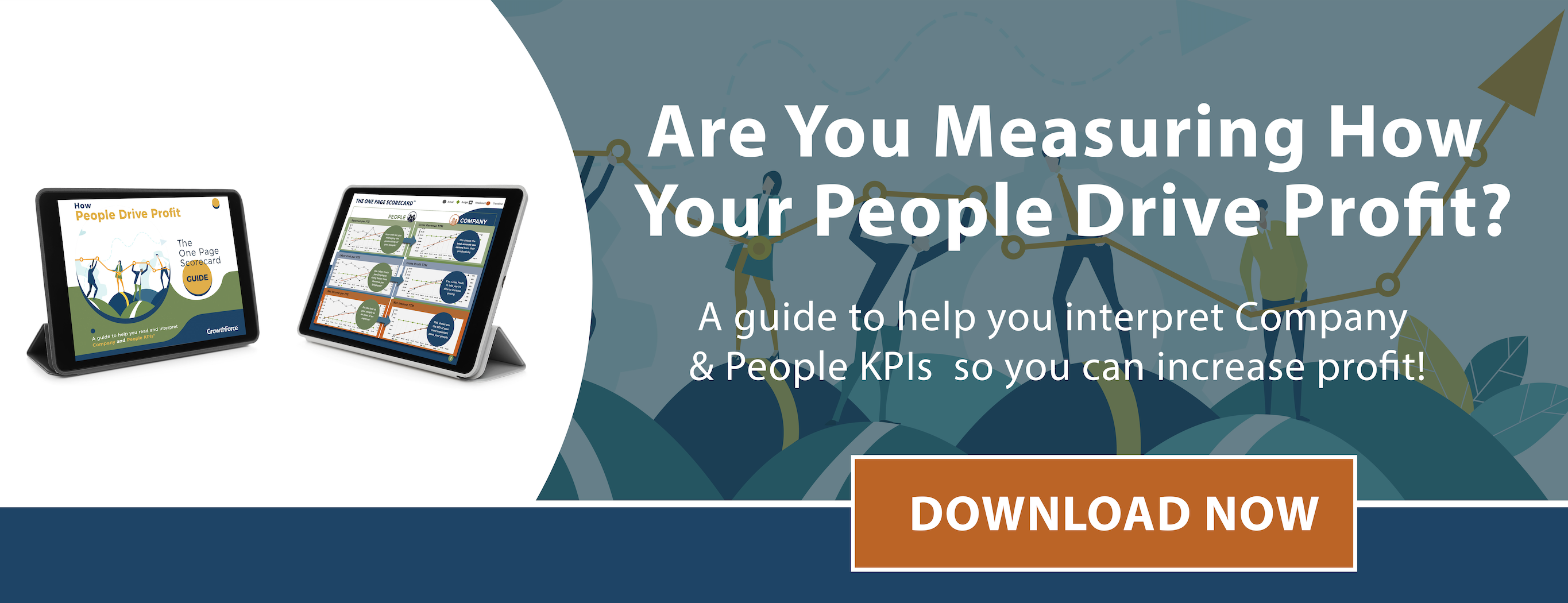7 min read

Look at any business's income statement, and employee-related costs will likely comprise the largest portion (or one of the largest portions) of overhead expenses.
While many business owners' first instinct might be to try to cut costs from this hefty category, the money you spend on your employees is well worth it.
|
Key Takeaways
|
It's time to stop looking at employees and the resources you spend on them as expenses and start thinking about them as investments.
Beware of the Post-Pandemic Employee Turnover Storm
In addition to the traditional employee satisfaction challenges that business leaders face in the workplace, the pandemic has also had an unprecedented effect on today's professional climate, exacerbating these challenges with new factors affecting turnover such as changing employee expectations, attitudes, and capabilities.
Studies in North America have shown that more than half of workers plan to search for a new job following the pandemic, and 1 in 4 workers plans to quit their jobs once the pandemic subsides and new opportunities flourish [4].
Respondents to these surveys provided various reasons for why they desire to leave their current jobs in search of new opportunities. In addition to the usual career-oriented reasons such as wanting a raise or promotion, the bulk of the reasons surrounded pandemic-related burnout.
Work from home has to throw a wrench in work-life balance- leading to disengagement and shifting perspectives that inspire people to go after YOLO (you only live once) opportunities [5]. Employers with healthy company culture and competitive benefits have a leg up in today’s job market.
The bottom line is (no pun intended)- now more than ever is the time to invest in your people.
What Happens When You Don't Invest in Your People?
Failing to invest in your people and view them as the revenue-driving asset that they are will lead to dissatisfaction among your people, a sour workplace culture, lost productivity, missed opportunities, and lost revenue.
And this all trickles down to your bottom line.
Unhappy workers are less productive- that costs you money in missed opportunities and lost revenue. According to a survey from Gallup that assessed the State of the Global Workplace, 85% of workers around the world are dissatisfied with their jobs [1]. In the big picture, that dissatisfaction represents about $7 trillion lost annually in productivity worldwide. When you fail to invest in your employees, your business will share in those losses.
Additionally, failing to invest in people and create a positive employee experience could dissuade top talent from joining your ranks. One study found that companies that actively cultivated a positive workplace culture, invested in employees, and created a positive experience for candidates benefited from hiring 70% better candidates in terms of resume quality [2].
And it doesn’t stop just there. Unhappy workers are also almost much more likely to leave, and that costs businesses big time. A study from IBM revealed that employees who don't believe they can achieve their career goals with their current employer are 12 times more likely to quit their jobs [3].
When employees aren't happy and satisfied in their jobs, when they don't feel appreciated, and when they don't have opportunities to realize their true potential, they quit and leave your company in search of better opportunities.
Let’s take a deeper look…
How Much Does Employee Turnover Really Cost Your Business?
If there is one takeaway you get from this article, it is that turnover is costly.
If you thought payroll was expensive, just wait until you find out how much employee turnover really costs your business.
The average cost of replacing an unskilled employee rings in at around 50% of the employee's salary. The cost of replacing a higher-level employee can soar up to and above 150% of the employee's salary! The reason why turnover is so expensive is that it forces your business to incur both direct and indirect costs of losing and replacing an employee.
Direct Costs of Employee Turnover
When your employee leaves, you'll need to pay out any of their accrued paid time off immediately with their final paycheck. You'll then incur the labor costs and potential overtime expense of employees who are redirected to cover the former employee's responsibilities until a replacement can be found
Simply, finding a replacement will cost even more money – whether you hire through a recruiting firm or pay to advertise the position. Additionally, external hires tend to ask for higher starting salaries than internal hires, raising your ongoing overhead costs.
Indirect Costs of Employee Turnover
The indirect costs of employee turnover are slightly harder to predict and calculate, which, in a sense, makes them worse than direct costs because they're more difficult to plan for.
To start, losing an employee, a member of your team, can feel like losing a close friend. To ensure employee morale and company cultures stay solid throughout the transition, you'll likely invest in more team-building activities like lunches or company outings and also spend more time in one-on-one meetings to check in with the rest of your employees.
When an employee quits, productivity lags until they can be replaced with a new employee and that person is fully trained, up to speed, and operating at their full capacity. This prolonged lapse in productivity results in lost revenue. While your new employee is onboarding, you'll likely also divert a high-performing employee to train them, which means you lose even more revenue.
Employee turnover can also create indirect costs with the effect it has on your clients.
Turnover could cause you to lose clients because they follow an employee, they're tired of dealing with a new person every time they do business with you, or because turnover has led to discontinuity and diminished the quality of your services. Whatever the reason, turnover will undoubtedly hurt your client base and your revenue as a result.
Do This- 3 Steps To Take Now To Prepare For The 'Turnover Tsunami'
1. Assess Your Organization
Each organization is different- it boils down to finding out what your people need.
To minimize turnover in your business, it's essential to prepare your organization for this inevitable mass workforce migration. You should conduct an organizational assessment to evaluate aspects of your business like operations, communications, customer service, sales, marketing, or other departments. Ask your employees for their feedback and suggestions for improvement.
 The pandemic has undoubtedly changed everyone's perspectives, habits, and daily lives. It has even impacted our culture on a greater scale. Consider how these types of changes might affect your own employees and what they desire in a workplace and career.
The pandemic has undoubtedly changed everyone's perspectives, habits, and daily lives. It has even impacted our culture on a greater scale. Consider how these types of changes might affect your own employees and what they desire in a workplace and career.
Consider how a different workplace style, design, or lifestyle benefits (in addition to traditional benefits) might persuade employees to stay with your company or even attract top talent to you. Can your workplace offer remote work or flexible hybrid working opportunities? Can you provide a childcare solution for parents who are not yet comfortable sending their children back to school?
2.Invest In Your Company Culture
So, how can you improve employee retention and maximize profitability in your people?
By investing in a winning human capital management strategy that's designed to generate positivity, support employees, provide growth opportunities, and also encourage everyone by recognizing achievements.
You can actively create a positive workplace culture with team-building activities and collaborative workflows that allow your employees' voices to be heard and for them to have a stake in the process. Additionally, it's important to set goals and specific benchmarks for employees to reach. Always outline a clear framework for achieving these goals and communicate how these benchmarks will move your company toward a larger, long-term goal. This will orient your entire organization around a common vision, creating camaraderie and a more fulfilling purpose.
When you focus on your culture and people, you'll automatically begin to see the positive impact on your bottom line. Organizations with positive company cultures enjoy 72% higher employee engagement than those with high-stress, cutthroat, or negative cultures [6].
More employee engagement means greater productivity and a maximized ROI...
3.Implement Recognition + Reward System
Recognize and reward employee achievements.
Monetary rewards like bonuses can do a lot to motivate employees and make them feel appreciated. That being said, recognition is even more important. Whether your employees meet a goal or go above and beyond your expectations of them, you absolutely must take the time to recognize them among their coworkers.
This not only gives your top-performers the credit they deserve, but it also identifies the individuals whom lower-performing employees can look up to, emulate, and whose performance they can strive to match.
But it doesn’t necessarily have to be monetary rewards- Take advice from a recent 🎙️ Path To Profit Episode with Andrew Jackson, CEO of BravoTech.
Jackson has found new ways to reward employees in the remote workplace: “We designed an MVP background to use on Zoom meetings. Now, the winner gets a virtual background that’s bright, shiny with lots of stars. They get to use it for the week after being declared MVP.”
Measure the Success of Your Human Capital Strategy
With a robust back office, you'll be able to track and measure the ROI of your human capital strategy. You'll be able to track the improvements in your employee turnover rate, revenue per full-time employee, ROI on labor costs, income per hour paid, and more.
All of these metrics found in your Company + People Scorecard will reveal the true impact that investing in your people and workplace culture has on your bottom line and your company's future.
[1] https://www.gallup.com/workplace/238079/state-global-workplace-2017.aspx
[2] http://resources.glassdoor.com/rs/899-LOT-464/images/50hr-recruiting-and-statistics-2017.pdf
[3] https://www.ibm.com/training/pdfs/IBMTraining-TheValueofTraining.pdf
[6] https://www.denisonconsulting.com/sites/default/files/documents/resources/rn_engagement_0.pd



